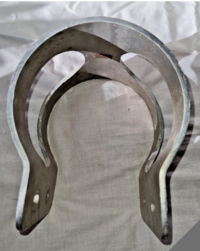The Standard
XS650 Addict
Adding a Circle Industries style fork brace on 34mm front end - '72 model bike.
On the topic about fork stiction and the brace being installed should have a slip fit between the fork lowers. If the brace being installed is too wide or narrow as-is, can it be widened or narrowed at the mounting portion off the bike to shape it to the slip-fit spec? Or does that compromise the brace's structural rigidity and performance afterwards? Brace is aluminum.
Other thought is if brace's exterior mounting surface is narrower than the fork tube mounting hole face, to shim difference with washers or an aluminum spacer. Won't look as good but would this functionally work without taking away from the brace's intended added performance?
My measurement of fork lower spacing (inside face mounting holes across) is 5-1/8". The fork brace I have is 4-1/8" wide at the fork lower section mounting holes section. As seen in the picture, the brace has more of an upside down "Omega" shape that "U" with straight or 180 degree, vertical profile. Would opening the span of the brace and straightening one or both lower mounting sections for a slip-fit at 5-1/8" weaken the brace or not relevant the way the brace works with keeping lowers from rotating?
As being new to how these work in improving front fork performance, I have heard they keep the forks or lowers from rotating and also keep the forks from flexing outside of the parallel track down from the upper and lower triple clamps. The latter makes sense to me but I do not follow the part about it keeps the forks or lowers from rotating?
On the topic about fork stiction and the brace being installed should have a slip fit between the fork lowers. If the brace being installed is too wide or narrow as-is, can it be widened or narrowed at the mounting portion off the bike to shape it to the slip-fit spec? Or does that compromise the brace's structural rigidity and performance afterwards? Brace is aluminum.
Other thought is if brace's exterior mounting surface is narrower than the fork tube mounting hole face, to shim difference with washers or an aluminum spacer. Won't look as good but would this functionally work without taking away from the brace's intended added performance?
My measurement of fork lower spacing (inside face mounting holes across) is 5-1/8". The fork brace I have is 4-1/8" wide at the fork lower section mounting holes section. As seen in the picture, the brace has more of an upside down "Omega" shape that "U" with straight or 180 degree, vertical profile. Would opening the span of the brace and straightening one or both lower mounting sections for a slip-fit at 5-1/8" weaken the brace or not relevant the way the brace works with keeping lowers from rotating?
As being new to how these work in improving front fork performance, I have heard they keep the forks or lowers from rotating and also keep the forks from flexing outside of the parallel track down from the upper and lower triple clamps. The latter makes sense to me but I do not follow the part about it keeps the forks or lowers from rotating?

